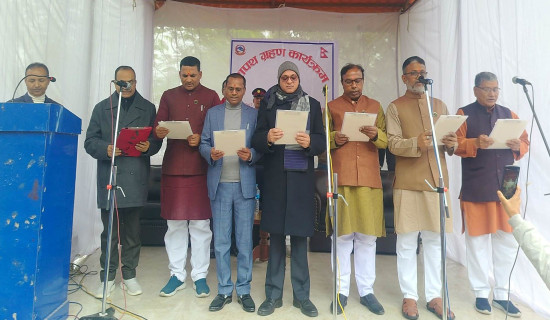- Wednesday, 31 December 2025
Policy To Ease Liquidity
In a major step to tame ongoing recession, Nepal Rastra Bank (NRB) has lowered the interest rate by one percentage point, hoping that it will boost credit in the banking sector and economic activities in general. Reviewing the monetary policy in its third quarter of current fiscal year 2022/23, the central bank Friday cut the bank rate from 8.5 per cent to 7.5 per cent, a step intended to promote private sector-led investment. Rescheduling of loan payment and revival of refinancing programmes are supposed to ease the liquidity crisis that continues to bite the economy even after the post-pandemic phase. The banking and financial institutions are facing the liquidity crunch to an unprecedented level while the widening trade deficit and inflation have taken its toll on the economy. As a result, the country is unable to meet its growth target. Due to the high interest rate, entrepreneurs shied away from investing their money in the industrial sector.
The NRB has made the monetary policy flexible with a view to addressing these economic troubles, which goes against the normal practice of maintaining tight or stable policy. The NRB has introduced a package to provide relief to microfinance institutions and their borrowers. Accordingly, the loans of microfinance institutions can be restructured by mid-July 2023 and the refinancing will be provided to the sectors whose growth rate has been negative over the last six months. Similarly, the loans disbursed to hotels and restaurants, livestock farming and the construction sector, and loans of up to Rs. 50 million given to other sectors will be restructured within mid-July 2023. These facilities are expected to ensure economic stability internally and externally. At the moment, the central bank is in a position to mobilise Rs. 57 billion in refinancing that can check the economic slowdown, affecting the manufacturing, construction, and wholesale and retail trade.
Nonetheless, the country's economic condition is not as bad as depicted in the media. According to the NRB, the external sector has improved, resulting in the easing of the liquidity situation. The non-performing loan ratio in banks and financial institutions has slightly gone up. With the declining price growth rate of imported goods, the pressure on the prices is decreasing gradually. A fall in demand of imported items and petroleum products will lead to the decline in prices. The country has witnessed an increase in remittance and deposits while the loan demands have gone down, making easy for the banks in managing funds. But the government is yet to fully tame the runaway inflation. It is still slightly above the target. Average inflation in the first nine months of the current fiscal year stood at 7.91 per cent. The prices of food, dairy products, household consumables, imported goods and fuels have shot up with devaluation of Nepali rupee. The government had planned to keep inflation at 7 per cent in its current fiscal year budget.
On the flip side, the government's ambitious goal of attaining 8 per cent economic growth is set to hit the roadblocks. The National Statistics Office states that economic growth will be just 2.16 per cent in basic prices and 1.86 per cent in producer prices in current fiscal year. However, it is hoped that capital expenditure can increase after the liquidity problem gets eased and interest rates decline. The government needs to bring policy to encourage the investment of remittances in productive sectors to inject a new life into the flagging economy. Likewise, cutting profligate spending under the general expenditure can also help overcome the existing economic woes.
















